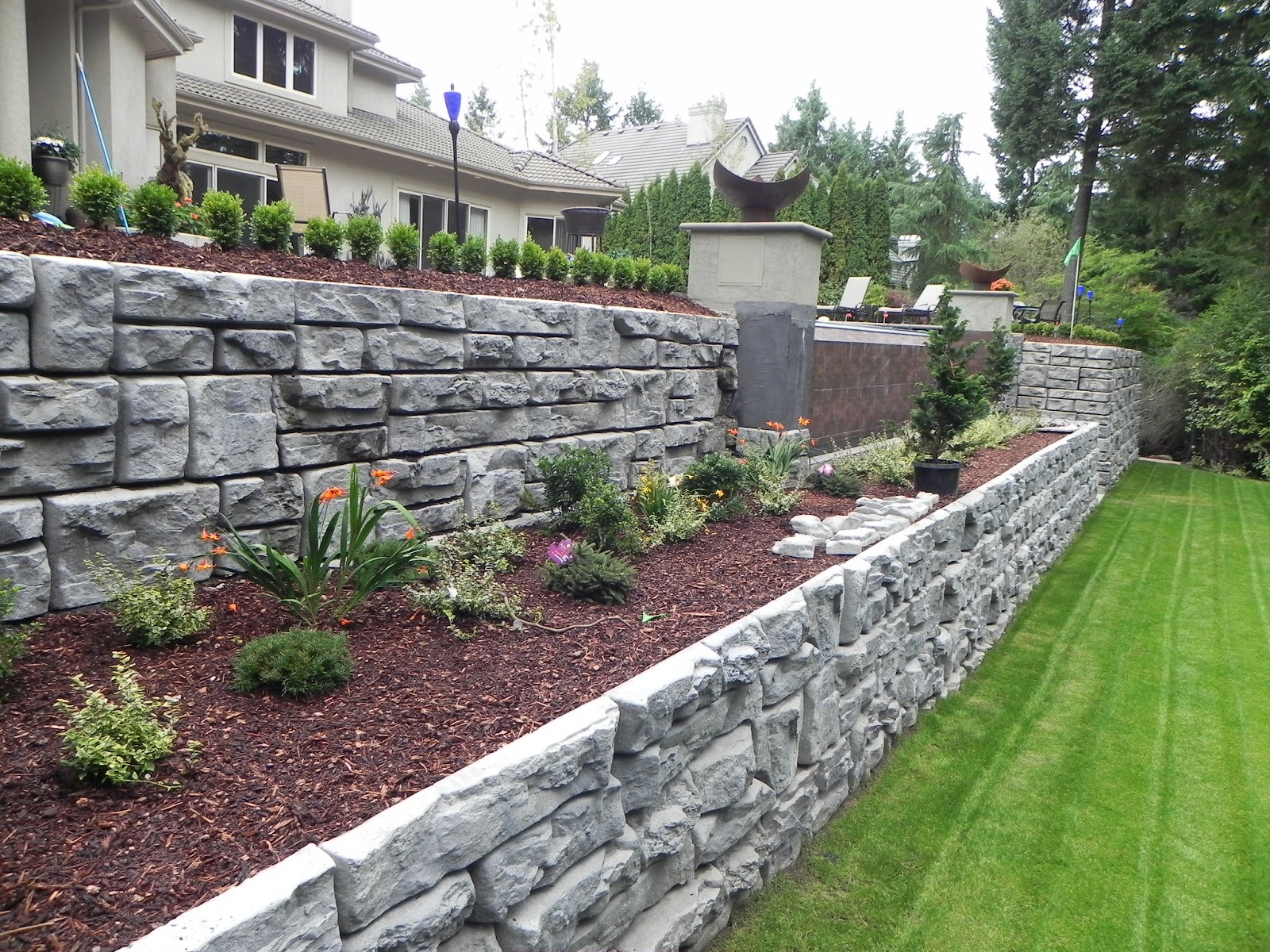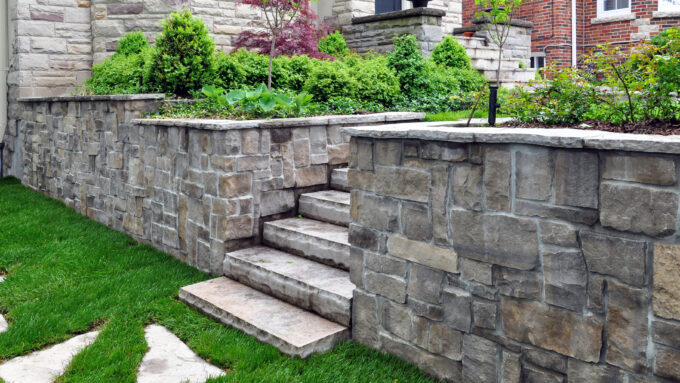Making Sure Architectural Honesty: The Value of Appropriately Created Preserving Wall Surfaces in Protecting Against Incline Failure
In the world of civil design and construction, the importance of correctly created maintaining walls in preventing slope failure can not be understated. These structures serve as critical safeguards against the all-natural pressures that can destabilize slopes and create potentially disastrous effects. Recognizing the thorough layout considerations, building and construction approaches, and maintenance techniques related to keeping walls is fundamental in ensuring their efficiency and long life. By checking out the elaborate interplay between these components, a much deeper comprehension of the crucial role that keeping wall surfaces play in maintaining architectural integrity and preventing incline failing emerges. Retaining Walls Sunshine Coast.
Role of Retaining Walls in Stability
The indispensability of keeping walls in ensuring slope stability is vital in civil design methods. Retaining walls serve a vital function in avoiding dirt disintegration, managing water drainage, and maintaining the architectural integrity of inclines. By sustaining vertical or near-vertical grade modifications, preserving wall surfaces assist to redistribute lateral pressure exerted by the dirt, thereby reducing the risk of slope failing.
One trick feature of maintaining walls is to neutralize the force of gravity acting upon the dirt mass behind them. This is achieved through proper design and building, which thinks about elements such as soil type, wall elevation, drain arrangements, and possible additional charge lots. By effectively keeping dirt within defined boundaries, these frameworks aid to stabilize slopes and avoid landslides.
Furthermore, keeping wall surfaces add to the appearances of landscapes while offering useful benefits. They can develop terraced levels for landscaping, support highways or frameworks on hillsides, and enhance the total functionality of sloped terrain. In essence, preserving walls play a vital role in preserving incline stability and ensuring the security and long life of civil design tasks.
Factors Affecting Wall Surface Performance
Factors that influence the performance of preserving walls consist of dirt residential or commercial properties, wall surface style, and exterior lots. Appropriate wall surface design takes into consideration elements like wall height, wall surface kind (e.g., gravity walls, cantilever wall surfaces), reinforcement materials, water drainage systems, and building strategies to make sure the wall surface can hold up against the side stress put in by the retained dirt. By thinking about these elements adequately, designers can build preserving walls that effectively avoid slope failing and make sure long-term architectural integrity.
Design Factors To Consider for Preserving Wall Surfaces
Incorporating the critical facets of dirt residential properties and external loads right into the architectural style process is essential for creating efficient keeping walls that guarantee incline stability. When designing retaining walls, engineers must thoroughly review the characteristics of the surrounding dirt, including its compaction, kind, and drainage residential or commercial properties. Understanding these soil buildings is essential for establishing the suitable wall support, thickness, and height needed to hold up against the side stress applied by the soil mass.
Furthermore, outside loads such as surcharge lots from neighboring frameworks or traffic, in addition to seismic pressures, must be thought about during the layout phase. These tons can considerably affect the stability and efficiency of a preserving wall, demanding making use of appropriate style methods and materials to minimize prospective failure threats.
Furthermore, the choice of ideal materials, such as concrete, rock, or hardwood, ought to line up with the site-specific problems and visual requirements. you can try here Variable of safety considerations, drainage arrangements, and building and construction techniques are also important elements that influence the general style and functionality of preserving wall surfaces in preventing incline failing. By carefully considering these design considerations, engineers can ensure the architectural honesty and lasting security of retaining walls.

Construction Best Practices for Resilience
When building maintaining wall surfaces for optimum durability and long life, adherence to industry-standard strategies and thorough focus to information are vital. To make certain the toughness of a retaining wall, proper website prep work is important. This includes sufficient compaction of the dirt, proper drainage systems, and guaranteeing the wall's structure is audio. Utilizing premium materials, such as cinder blocks or all-natural stone, is crucial for the durability of the structure. In addition, utilizing competent professionals with experience in creating maintaining walls can considerably influence the toughness of the final item.
Including reinforcement techniques, such as geogrids or steel bars, can enhance the architectural honesty of the preserving wall surface and stop possible failings. By complying with these building and construction finest methods, maintaining walls can endure the test of time and efficiently prevent slope failing.
Relevance of Correct Upkeep
Regular maintenance is crucial for protecting the architectural stability and capability of keeping walls over time. To guarantee that retaining wall surfaces proceed to perform their designated feature successfully, normal assessments should be carried out to recognize any indications of wear and tear.

Conclusion
In conclusion, keeping walls play a crucial function in making certain architectural honesty and protecting against incline failing. By taking into consideration factors influencing wall effectiveness, adhering to design considerations, following construction ideal practices, and implementing correct upkeep, the longevity of retaining walls can be optimized. Retaining Walls Sunshine Coast. It is necessary to recognize the value of correctly created retaining wall surfaces in keeping find more stability and avoiding potential hazards related to incline failing
Variables that affect the effectiveness of retaining wall surfaces include dirt residential or commercial properties, wall layout, and exterior tons. Proper wall surface design takes into consideration aspects like wall surface elevation, wall kind (e.g., gravity walls, cantilever wall surfaces), reinforcement products, water drainage systems, and construction techniques to ensure the wall can hold up against the lateral stress exerted by the preserved soil. By thinking about these variables adequately, designers can create preserving wall surfaces that successfully protect against incline failing and make certain long-lasting structural stability.
Upkeep tasks may consist of clearing water drainage systems to prevent water accumulation behind the wall surface, repairing any kind of visible splits or damage, and making certain that the wall is complimentary from vegetation that might put in pressure on the structure. By taking into consideration elements influencing wall surface effectiveness, adhering to make considerations, adhering to construction best methods, and applying proper maintenance, the durability of preserving walls can be maximized.